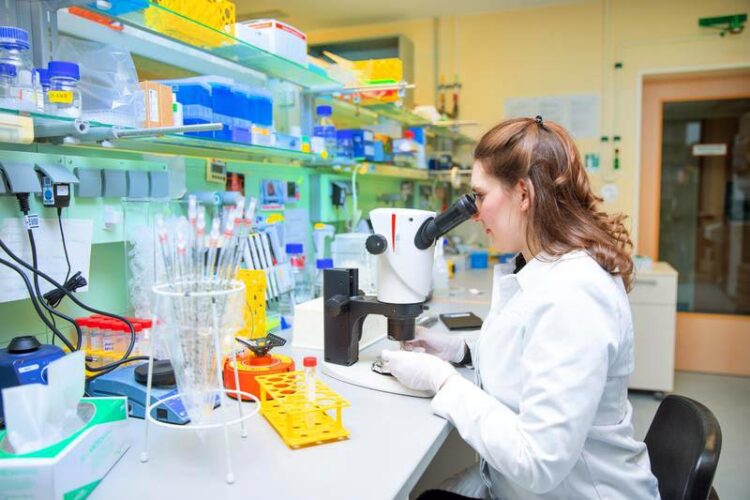On the trail of nerve ageing

Wants to elucidate the age-related changes in peripheral sensory nerve cells: Dr Caroline Perner. Copyright: Karin Kaiser / MHH
MHH junior researcher investigates the influence of the immune system on age-related disorders of sensory neurones.
The peripheral nervous system includes sensory and motor nerve cells that run through our body in bundles like power cables. Motor nerve cells transmit instructions from the brain to the muscles. Sensory nerve cells inform us about our position in the environment and what is happening in our body. They transmit stimuli from the sensory organs to the brain – i.e. what we see, hear, smell, taste and feel. They also help us to coordinate our movements and are important for balance and equilibrium. However, the sensory neurones are not only responsible for sensory perception, but can also react directly to stimuli in the tissue and regulate tissue and immune processes via messenger substances known as neuropeptides. As a result, they play a decisive role in combating pathogens and allergic processes and influence wound healing. At the same time, the nerve cells are activated and sensitised by cytokines. These are messenger substances that are formed when the immune system reacts and influence inflammatory processes.
Dr Caroline Perner, head of a junior research group at the Department of Haematology, Haemostaseology, Oncology and Stem Cell Transplantation at Hannover Medical School (MHH), is investigating how the exchange between sensory nerve cells and the messenger substances in their immediate environment changes with age. To this end, she wants to precisely describe the age-related changes in stimulus recognition and stimulus response in sensory nerve cells and also decipher whether immune cells play an active role in this process. The Else Kröner-Fresenius Foundation is supporting the neurologist with the prestigious Memorial Scholarship for particularly talented young doctors and is funding her work with 250,000 euros over two years.
Changed release of messenger substances
In the course of our lives, our immune defences weaken, injuries heal more slowly or incompletely, chronic pain and itching sensations increase with age and impair our quality of life. In addition, disorders of the peripheral nerves make it difficult to perceive the body in space and lead to gait instability and an increased risk of falling. Dr Perner assumes that this is not an inevitable phenomenon of ageing nerves, but the result of chronic inflammation. “We suspect that the age-related loss of function in the peripheral nervous system is caused by a very specific mechanism and affects certain subgroups of sensory neurones differently,” says the neurologist. “However, we don’t yet understand exactly why this is the case.” One reason could be an altered release of the messenger substances. In preliminary studies, the scientist has already been able to show in a transplant model that cells of the immune system apparently have an important influence. She exposed young neurons to the influence of old immune cells: “Within a few weeks, the peripheral sensory nerve cells were reprogrammed and the actually young nerve cells now exhibited characteristics and functions of old nerve cells.”
Communication between nerve and immune cells
In her project, Dr Perner and her research team now want to find out how the excitability of sensory neurons and the release of neuropeptides are influenced by age and how the bidirectional communication between sensory and immune cells changes. “Specifically, we want to measure how strongly the various sensory nerve cells are excited by certain stimuli, i.e. how strong the signal is that the cells transmit,” explains the head of the “Neuroimmunology” research group. Among other things, the researchers use capsaicin, a chemical compound that occurs naturally in chillies, among other things. Capsaicin acts on certain receptors of a specific subgroup of sensory neurones, causing a heat and spiciness stimulus and increasing blood flow through the simultaneous neuronal release of neuropeptides into the tissue. “We are investigating whether old nerve cells react weaker or stronger to different stimulants than young ones.” The scientist also wants to find out how many of these messenger substances the nerve cells release when they come into contact with certain stimulants such as capsaicin in cell culture. The team is using different nerve cell cultures for the experiments.
The aim of the investigations is to find out which immune cells and, more specifically, which messenger substances influence the age-typical reactions of the sensory nerve cells. “Once we know this, we will have a target structure for the first time and can develop strategies to maintain the function of sensory neurones during ageing.” Then, Dr Perner hopes, the typical age-related problems associated with the loss of function could eventually be halted or even avoided altogether.
SERVICE:
For further information, please contact Dr. Caroline Perner, perner.caroline@mh-hannover.de
https://www.mhh.de/en/presse/mhh-insight/news-detailed-view/on-the-trail-of-nerve-ageing
Media Contact
All latest news from the category: Health and Medicine
This subject area encompasses research and studies in the field of human medicine.
Among the wide-ranging list of topics covered here are anesthesiology, anatomy, surgery, human genetics, hygiene and environmental medicine, internal medicine, neurology, pharmacology, physiology, urology and dental medicine.
Newest articles

NASA: Mystery of life’s handedness deepens
The mystery of why life uses molecules with specific orientations has deepened with a NASA-funded discovery that RNA — a key molecule thought to have potentially held the instructions for…

What are the effects of historic lithium mining on water quality?
Study reveals low levels of common contaminants but high levels of other elements in waters associated with an abandoned lithium mine. Lithium ore and mining waste from a historic lithium…

Quantum-inspired design boosts efficiency of heat-to-electricity conversion
Rice engineers take unconventional route to improving thermophotovoltaic systems. Researchers at Rice University have found a new way to improve a key element of thermophotovoltaic (TPV) systems, which convert heat…



